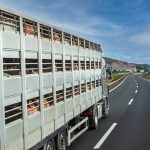A few months ago I was talking with Jim Wood, chief sales and operations officer, at the Rocky Mountain Equipment dealership chain. He voiced concern at the time about equipment owners who were deleting the emissions systems in their late-model equipment.
Aside from the issues this creates at dealership service departments, he expressed concern that those emissions systems were there to comply with federal laws. And he wondered what legal liability farmers might be letting themselves in for by disabling them.
Read Also

Riding the tariff roller-coaster
What producers are doing to minimize the risk created by ongoing trade uncertainty.
I wondered the same thing, so I decided to investigate, phoning and emailing a number of government agencies at the federal and provincial levels.
What did I find out?
Well, regulations are in place in North America requiring manufacturers to build and install emissions systems that meet standards, and dealerships cannot sell new machines that don’t meet those standards. However, once that tractor or combine gets to its new home, all bets are off. There is no practical enforcement anywhere in Canada I could find that puts farmers in any legal risk for removing them — for now, at least.
But the risk to owners might be more substantial than the environment ministry’s equivalent of a traffic ticket. If things go bad on a high-horsepower machine — as has happened more than a few times across the country — farmers can be left holding the bag for a repair bill so expensive that it might make them a little light-headed.

“One of the big issues is that if any variation or modification is done when the unit is new, basically the warranty is null and void,” says Larry Hertz, vice-president Canada for the Western Equipment Dealers Association (WEDA). “That’s a concern of our dealers, because the manufacturers have made it very clear there’s no warranty. Then the dealer is stuck in the middle. When a farmer buys it, if they decide to chip it to increase horsepower, often what they do at the same time is delete the emissions systems. Often the companies that sell that stuff do both of those.”
While Hertz couldn’t say exactly how often machines are coming back to WEDA member dealerships with modification-induced engine failures, he notes that the problem is big enough that the association has launched a public awareness campaign to ensure farmers are forewarned about the risks of going around modern emissions systems or “chipping” the engine to drag a few more horsepower out of it.
“I can’t really put a number on it,” he says. “But we have heard from dealers that farmers are faced with $50,000 or $100,000 repair bills. That’s the scary part. Who’s going to pay for that? We have heard of combines and tractors having engine failures in their first year. It’s a real problem. Some guys are doing it on new units, and they don’t realize the implication: they’re not going to have a warranty.”
It isn’t hard to find a shop that will sell and install a “chip” to modify an engine control module, which essentially means reprogramming it. If an engine emissions system is deleted from that OEM computer program, there is no more need to go through those annoying periodic regeneration stages. And many farmers have complained that the most common problem they experience with late-model machines is an emissions system failure, causing them downtime when there really isn’t anything wrong with the tractor. Then add the horsepower bonus to that and it’s easy to see there is genuine appeal for someone to pay the $3,000 or so for a chip.
“They’re trying to get more horsepower out of an existing tractor to pull an air drill that has five more feet of width,” says Hertz. “Or they may want to add a liquid cart in behind and they just don’t have enough horsepower.”
Spending the money on a chip is significantly less than the trade-in cost of moving up to a bigger tractor to handle increased load requirements.
“There are some companies that will literally go out the day after a new tractor is delivered and put their system on,” Hertz continues. “They say it’s warranted. Well, the system they put on, whether it’s a $2,500 module or whatever, sure, that’s warranted. But the tractor isn’t. So farmers are either not getting the full story or not thinking through the implications.”
If a chipped tractor or combine suffers a breakdown, getting it back into service becomes a little complicated.
“The first thing our dealers have to do is get it back to OEM condition before they can even work on it,” Hertz says. “If I’m harvesting with a couple of thousand acres left to do and a technician comes out and can’t even work on it — and we have had situations like that — the technician couldn’t even diagnose what the problem was, because it had been modified. So the farmers call up whoever put the chip in it to come out and remove it, and that could take half a day, a day or even two, before the technician even works on it. That’s a scary situation for me as a farmer.”
Even if the machine doesn’t experience a problem, there is the broader implication of what happens a couple of years down the road. WEDA thinks chipping adds a level of uncertainty to the market for used equipment as well as a new minefield that used equipment buyers have to navigate.
“What happens if it’s a used unit two, three or four years old and it’s been sold to another farmer,” Hertz asks. “If I was a farmer these days, I’d be asking, has this thing been modified? I’d even put that on the bill of sale so there is some sort of recourse. What happens if this thing blows up in my field six months or a year after I bought it and I find out it’s been chipped and overheated or whatever?”
Dealers face the same risk when accepting a trade-in, so WEDA is recommending that its members demand an assurance from the owner that the ECU is untouched. If an owner can’t or won’t do that, it could mean a significant reduction in the trade-in value or an outright refusal by the dealer to accept it.
“Dealers usually know their customers really well,” he says. “But they might not know if a machine has been modified, so that’s what we’re recommending, having their customer sign something.”
The counter argument to all this coming from many producers and those who provide chipping services is many tractor models in a brand’s lineup are nearly identical, except for the horsepower ratings. So why not just boost the fuel pump output to get everything out of that diesel that it’s capable of delivering?
But Hertz dismisses that notion.
“It’s not really true,” he says. “Some farmers would think that a particular tractor is the same. It has the same block, same transmission, same differential, the whole nine yards. But it’s really not. A manufacturer may take a particular tractor model and increase horsepower through modifications to the engine. They’ve tested that. But they’re also looking at whether the final drives and transmissions will handle that. They may have beefed that up. The farmer may look at that model number and think it’s the same as the next model number up, but they don’t really know what’s been done to the rest of tractor by the manufacturer to make sure it’s going to handle that horsepower.”
He says a look at what has gone on elsewhere proves his point. Overtaxing cooling systems is one of the most common problems suffered by chipped engines.
“I’ve talked to a lot of people in the trucking industry and they say a lot of the failures (from chipping for more horsepower) they have is in the piston closest to the truck cab. It’s farthest away from the radiator and gets less air cooling while it’s being driven. The trucking industry has generally moved away from this.”
And, of course, today’s onboard computer modules do much more than handle fuel delivery.
“It comes down to liability and safety,” Hertz says. “That’s really the crux of this whole thing.”
As with any industry today, there is also public perception. Farmers currently enjoy some measure of respect from consumers, but what would a viral YouTube video of a tractor spewing excess smoke from the exhaust do to the mindset of many who are more motivated by ideology than intelligent understanding? It certainly wouldn’t be helpful. Similar isolated incidents in different aspects of agriculture, such as animal welfare, have done that many times before.
“We talk about environmental farm plans and sequestering carbon and all the good thing farmers do,” says Hertz. “Farmers are always under the gun for using pesticides. And it bothers me farmers would consider modifying emissions systems to potentially create a whole bunch of bad press. Why do farmers, who are battling consumer perspectives on things they see negatively, want to go back to blowing black soot out of their tractor’s exhaust stacks? It concerns me that if we do start deleting these systems, we’re going to take two steps back.”
















